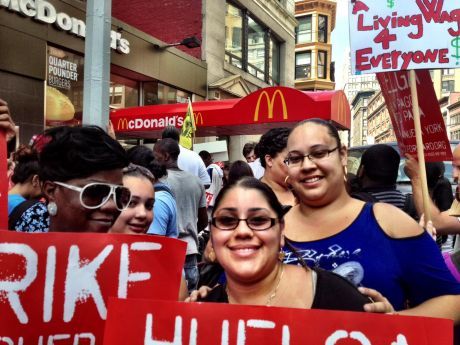News
You are here
Without our brains and muscle not a single burger can flip!

August 8, 2013
On Monday, July 29, hundreds of workers at Wendy’s, McDonald’s, Domino’s Pizza, KFC and other restaurants walked off the job in New York City, spearheading a week-long series of one-day strikes in seven US cities: New York, Chicago, St Louis, Detroit, Milwaukee, Kansas City and Flint.
Most of the strikers earn close to the federal minimum wage of $7.25 per hour. At the forefront of workers’ demands is a minimum wage of $15 for fast food workers, and the right to unionize and collectively bargain.
The advocacy group Fast Food Forward, made up of labour and community organizations, faith-based groups, and others concerned for the interests of low-wage workers has helped to coordinate the demonstrations and give expression to the demands. Their petition for a raise in wages and living standards for fast food workers has collected more than 125,000 signatures, while the message of low-wage service workers is going far and wide (watch John Oliver trumpeting their demands and chastising their detractors on the Daily Show for a great laugh).
The series of strikes has made it possible to quite broadly dispel some of the myths associated with the service/retail sector; taking on the common misconceptions that fast food workers are teens getting a bit of extra cash, that the companies cannot afford to pay their employees more, and so forth. The campaign has highlighted that the average salary of a fast food worker in New York City (NYC) is $11,000 per year while the average salary of most fast food CEOs is $25,000 per day; the median age of a fast food worker in America is 29 years old; McDonalds made $5.5 billion in profits last year; many fast food workers are forced to work two jobs or go on some kind of public assistance to afford the basic necessities like groceries, rent, childcare and transportation.
These high profile strike actions come after a couple of years that have seen strikes in New York and Chicago in November and April; a spontaneous walkout in a McDonald’s in New York over extremely hot working conditions; job action by Walmart warehouse workers, and pickets by Walmart customer service staff; La Senza, Macy’s and Victoria Secret’s workers walking off the job and occupying their workplaces; baristas organizing for better wages and collective bargaining, and a plethora of other labour disruptions in workplaces that fall outside the traditional area of the organized labour movement.
Lessons
These developments are incredibly important for a number of reasons. For years, many have rightly criticized the labour movement for not organizing the retail and service sectors, leading some to falsely counterpose organized and unorganized workers. However, these initiatives in fast food and Walmart--combining unions, workers fighting to unionize, and community groups--show that it is possible to unionize these sectors. This is an argument for unions to organize more of the emerging working class--rather than clinging to a dwindling membership while giving out concessions to employers--and for people outside of unions to see the importance of broadening and strengthening organized labour.
Despite all the academics who have made a living out of declaring the working class dead and buried, or replaced by a precarious class with different class interests and different methods of organizing--the working class exists and it wants better wages, better working conditions, and the right to join unions. These are the traditional demands of the labour movement, in the service sector which is adding jobs faster than any other sector of North American economy.
Finally, the strikes demonstrate the power of the working class when it decides to withdraw its labour. That $200 billion a year that comes in to the big fast food chains is only made possible by the brains and muscles of the workers cooking the food, ringing up sales, cleaning the floors, and driving the produce. A class-conscious service sector with the language of the Occupy movement and the power of the 99% is a force to be reckoned with.
Section:










